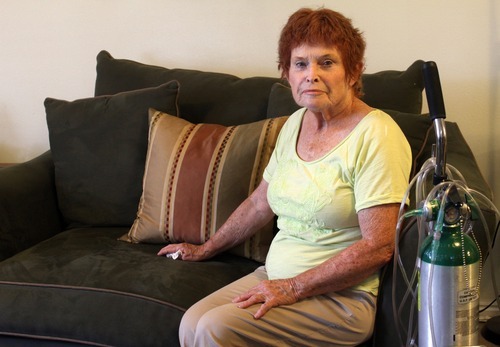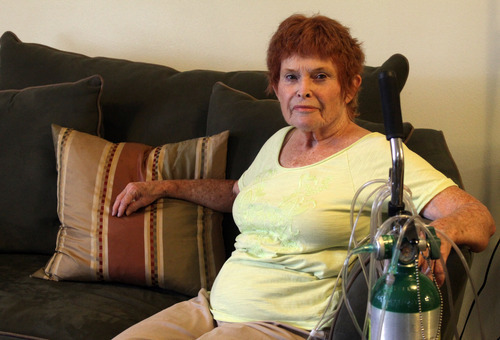This is an archived article that was published on sltrib.com in 2012, and information in the article may be outdated. It is provided only for personal research purposes and may not be reprinted.
Anita Bradford avoids people with the sniffles and keeps a close watch on air quality. Even on yellow-air-quality days, the 78-year-old's terminal lung disease bids her to lie low and stay indoors.
But seclusion wasn't enough to escape the ash-laden smoke billowing from the Wood Hollow Fire over Bradford's Spanish Fork home.
"When that stuff came over the mountain I told my husband, 'We've got to get out of here,' " said Bradford, who packed the car and fled to California for an impromptu vacation. "We stayed away for a week and had a good time. But it was an expense we hadn't budgeted for."
Utah's wildfire threat may have subsided. But Bradford still bristles at bearing the brunt of ill health and the costs.
The Wood Hollow Fire, caused by arcing power transmission lines, started June 23 and took 10 days to contain. One of the hundreds of fires that scorched parched Utah lands this summer, the blaze cost nearly $4 million to fight.
"But for every $1 spent fighting these fires there are plenty more spent on related health problems," speculates Bradford. "These are costs that go relatively unseen."
There is no easy way of tallying these costs: the doctor visits, sick days and lost productivity. Evidence of a rise this summer in emergency room visits and hospitalizations for respiratory complaints is anecdotal.
Timpanogos Hospital reports about a dozen asthma-related visits during the Saratoga Springs and Alpine fires. The University of Utah's emergency department treated 31 more respiratory complaints this June than last June, despite seeing fewer patients overall.
"In one night the weekend before the Fourth [of July], I saw five people with severe symptoms, not just with a cough, but people we were admitting or keeping overnight," said U. ER doctor Troy Madsen. Normally, Madsen says he may see one or two such cases a shift.
Smoke from wildfires is a mixture of gases such as carbon dioxide and particles from burning trees and other plant materials, according to the U.S. Centers for Disease Control.
Large particles can burn your eyes and irritate your nose and throat. But it's the small particles, those 30 times tinier than the diameter of a human hair, that get sucked deep into the lungs and wreak havoc.
"Small children, seniors and people with lung and heart problems are more affected than the rest of us," said Kent Bott, staff meteorologist at the Utah Department of Environmental Quality.
There are numerous studies charting the health effects of urban air pollution from the burning of fossil fuels. Whether the short, sometimes higher bursts of pollution from wildfires have the same effects is an open question.
One Environmental Protection Agency-led study of a 2008 wildfire in North Carolina showed a link between smoke and increased emergency room visits for heart failure and lung diseases such as asthma, pneumonia and bronchitis.
Bott said Salt Lake County air monitors never registered above moderate levels for small or large particulates. Utah County had several yellow air days and one red day through late June and early July, he said.
Red air alerts are common in winter when temperature inversions trap pollution in the valley, sometimes for days on end.
But Madsen believes that while "people during the winter are used to having to stay indoors, the fires caught them off guard."
In some cases, heavy smoke may have been compounded by allergies, he added.
For Bradford, the health calculus was simple and so are the policy solutions to mitigate risks for wildfires.
The retiree has idiopathic pulmonary fibrosis, a scarring or thickening of the lungs. The cause of the condition is unknown. There is no cure or proven treatment; her only recourse is to avoid situations that make it worse.
This June that meant stocking up on oxygen and spending hundreds on gas and hotel fees.
"Others had it worse than me," she said. "A good friend of mine ended up with bronchial pneumonia. She had to be on heavy meds and not leave her house for a couple of weeks. Another neighbor ended up completely housebound and on oxygen."
No politician wants to be the party pooper who throws water on fiery patriotic celebrations. But "laser light shows are absolutely marvelous," said Bradford, who also favors stricter limits on gun use to curb those blazes lit by poorly-timed target practice.
"Our elected leaders aren't paying attention to the common good," she said. "They have too many powerful interests to answer to."
Twitter: @kirstendstewart









